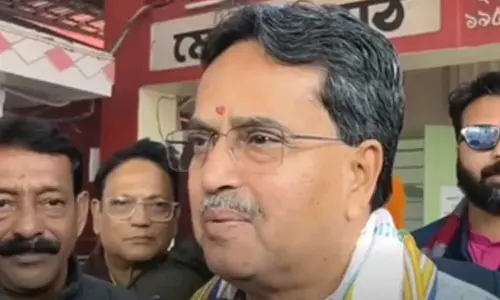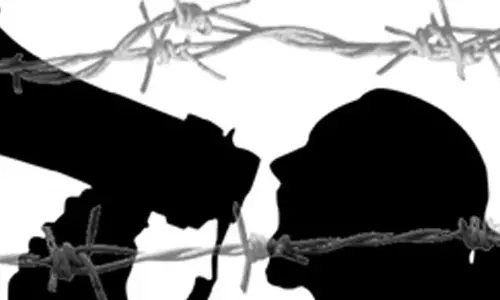My days as Secretary to Vice-President

Hidayatullah was a highly principled man, with many statesman-like qualities
Hidayatullah was a highly principled man, with many statesman-like qualities. He had originally accepted the post of VP as his candidature had been unanimously proposed by the ruling as well as all the opposition parties.
After Neelam Sanjiva Reddy completed his tenure as the President of India, speculation was rife about the possible successor to the highest officer of the land. At one point of time, all senior leaders of the opposition parties, including L K Advani, H N Bahuguna, Harkishan Singh Surjeet and others, called on Hidayatullah to try and persuade him to run for President. Hidayatullah insisted on my sitting through that meeting, explaining to me, later, that he wanted no misinterpretation, or out-of-context reference, to what was to transpire. I felt totally out of place, being called upon to be witness to such an important and historic occasion. At the end of the meeting, Hidayatullah, firmly but politely, declined the offer, saying that contesting an election was inconsistent, both within personal values and public image. “Zeb nahin deta,” were his actual words. Subsequently, the ruling party Congress (I) chose Giani Zail Singh as its candidate, who went on to become the President of the country.
In 1982, towards the end of the second year of my tenure, President Neelam Sanjiva Reddy was to retire and in election was to take place to fill that vacancy. Hidayatullah, quite naturally, had entertained hopes, that it might be he, who might be selected as the candidate, of the ruling party at the central government, for that election. But, then, politics being politics, it was, in the event, Giani Zail Singh, the then Union Home Minister, who was chosen by the then Prime Minister Indira Gandhi.
Given the majority the Congress (I) party enjoyed at the centre, and the composition of the state Legislatures, Giani-ji easily romped home with a comfortable majority.
Sometime later, Giani Zail Singh had to undergo a heart bypass operation and was advised rest, after the surgery, for a period of 45 days. In accordance with the relevant provisions of the Constitution of India, the VP was required to perform the duties of the President of India during that period.
Some years prior to that, when Justice Hidayatullah was the Chief Justice of India. Zakir Husain, the President of India, had completed his term and demitted office. V V Giri, the then Vice President, had resigned from his post to contest the Presidential Election. With the President’s position vacant and the Vice President not there, the Chief Justice of India was, in accordance with the provisions of the Constitution of India, sworn in as the acting President. When it was suggested to him that his position should be described as the ‘acting’ President, he pointed out that the Constitution provides that “there shall be a President of India…,” and that he was occupying that post, having resigned from the office of the Chief Justice of India. He was therefore the President of India – not the ‘acting’ President, he said. This position was accepted at that time.
This time, in 1982, the question was whether we should ask for a seal that read “President of India.” I advised him that, on this occasion, there was a President who, however, only was unable to discharge his functions. The Constitution provides that when the President is unable to discharge his functions the Vice-President will do so. Hence, the Vice President could only ‘act’ as the President in the given circumstances. Advice was sought of Peri Sastry, the then Law Secretary of India, who confirmed the stand I took. The Vice President, Justice Hidayatullah, was a person with vast experience sensitive to the feelings of other people and broad-minded in his approach appreciated the position and possible embarrassment was averted. Once the point had been made, he went along with the logic of it and things soon settled down to a satisfactory rhythm.
A formal ceremony had been arranged in the Rashtrapati Bhavan for the swearing-in of Hidayatullah to take over that position. Soon after the administration of the oath of office was completed, the VP was required to sign in a register by way of formalising the act of taking over office. That register was in an adjoining room, the access to which was through a narrow corridor. As I was returning with the register, I found Mrs Indira Gandhi at the other end of the corridor. We both waited for each other to go first and, eventually, she moved aside and waved her hand, saying, “Come, come.” And, upon returning home that evening, I proudly told my wife, Usha, that the Prime Minister of the country had spoken to me!
Accompanied by me, Hidayatullah would drive to Rashtrapati Bhavan every morning, and spend an hour there, disposing of papers relating to his duties as the President of India. Assisting him at that time, was a truly educating experience. I observed, an interesting aspect of the manner in which business was conducted in the Government of India. Senior civil servants, on the staff of the Prime Minister and other Union Ministers, would note in files on behalf of the Prime Minister or Ministers, after having obtained necessary orders, separately, in parallel, files maintained in their offices. Even cases relating to appointments of Governors of States would arrive at the President’s desk, with the appropriate recommendation signed by the Principal Secretary to the Prime Minister of India on her behalf. Something new for me having regard to the procedure I had been used to while working in the state government.
It was during that period that I had, quite innocently, got embroiled in an incident involving the missing of some confidential papers relating to the Ministry of External Affairs, from my drawer. It was only after Hidayatullah threatened to order a search, by the Central Bureau of Investigation, of the Presidents Secretariat, that, quite dramatically, the papers reappeared in my drawer one morning. A real close shave, that, one which gave me several sleepless nights.
Before I end this piece, here is an interesting incident from those days, worth repeating, though it has appeared in this column earlier. One day, as Hidayatullah was in the Chair, in the Rajya Sabha, a witty exchange took place between him, Indira Gandhi, the then Prime Minister, and the irrepressible Piloo Mody, a Member of that House belonging to the Swantanra Party. It was a Thursday, and, therefore, the Prime Minister’s day for replying to questions in the Rajya Sabha. While the discussion was going on, Piloo Mody found that Hidayatullah was repeatedly leaning to his right, craning his neck and turning his ear towards the Prime Minister whenever she spoke. Having observed this for a few minutes, Piloo Modi stood up and asked the Chairman whether, while the Prime Minister was undoubtedly a strikingly good-looking lady, was there any need for the Chair to look in her direction so many times. Bashfully, Hidayatullah was forced to make a confession that brought out a fact that even. I had not known earlier. Apparently, he wore a hearing aid inside the left rim of his spectacles and, had, therefore, to turn his neck to hear clearly, whenever someone spoke on his right side!
(The writer is formerly
Chief Secretary,
Government of
Andhra Pradesh)










